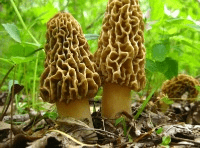Foraging Springtime Morels In Minnesota
Introducing a timely guest blog on foraging morel mushrooms. In about 10 days, it should be prime morel hunting in Sturdiwheat’s hometown of Red Wing, MN. Thanks, Mike, for sharing your knowledge and these helpful links. As you know, we love wild mushrooms on our galette crust, recipe HERE!
FINDING SPRINGTIME MORELS IN MINNESOTA 101

By Mike Kempenich, the “Gentleman Forager” www.gentlemanforager.com
Like him on www.facebook.com/gentlemanforager
When a person tells you they hunt mushrooms, invariably they speak of the morel—Morchella esculentoides. The fact that it is one of the first edibles to be found makes it an immediately popular mushroom, but the savory umami flavor of this delectable treat makes it prized the world over. To contribute further to its mystique, the morel has a very short window of availability—about 4 weeks at most, often less. What happens when fungiphiles are holed up for seven months with no outlet for their lust? They swarm like locusts into the woods, here in Minnesota, in late April or early May, depending on conditions.
So how does one go about finding this prized fungus? (click HERE to read more).
Although morels can be found associating with other trees (most often cottonwood, poplar and pine in the more northern parts of our state) they are most often found near the elm trees that used to dominate our landscape from mid-state southward. When the mushroom senses that its “host” tree is dying, it responds by producing the fruiting bodies that will carry its spores to potential new areas with healthy suitable host trees and conditions. This is most often made obvious by the bark starting to fall off of the tree. Elm trees have a very unique shape to their silhouette. The next time you are looking at an elm when its leaves are down, take time to note the shape is much like a witch’s broom standing with the handle to the ground. After you observe this a few times, and see that its bark is sloughing off, you will become much more adept at deciding which trees are worth a closer look.
So now you know where to look, how about when to look? The range of ground temperature that we are looking for is between 50 and 59 degrees—measured at a depth of 4” or so. On average, you will find morels of a size suitable for picking between four and seven days after a rainfall and assuming the temperature is within a suitable range. Read more HERE.
Are you ready to hit the woods?
Would you like to learn more, or become certified in identifying the morel and many other wild Minnesota mushrooms? You can sign up for one of Gentleman Forager’s classes or events at the links below!
Classes
http://www.gentlemanforager.com/#!classes-/ci1i
Black Morel Hootenanny May 20
https://www.facebook.com/events/218505211854080/
If you’re interested in more information about foraging this very popular mushroom, Mike also recommends you connect with this https://www.facebook.com/MikeologyStore as well. It is a larger forum he runs with about 5,000 members sharing information on mushroom foraging.
